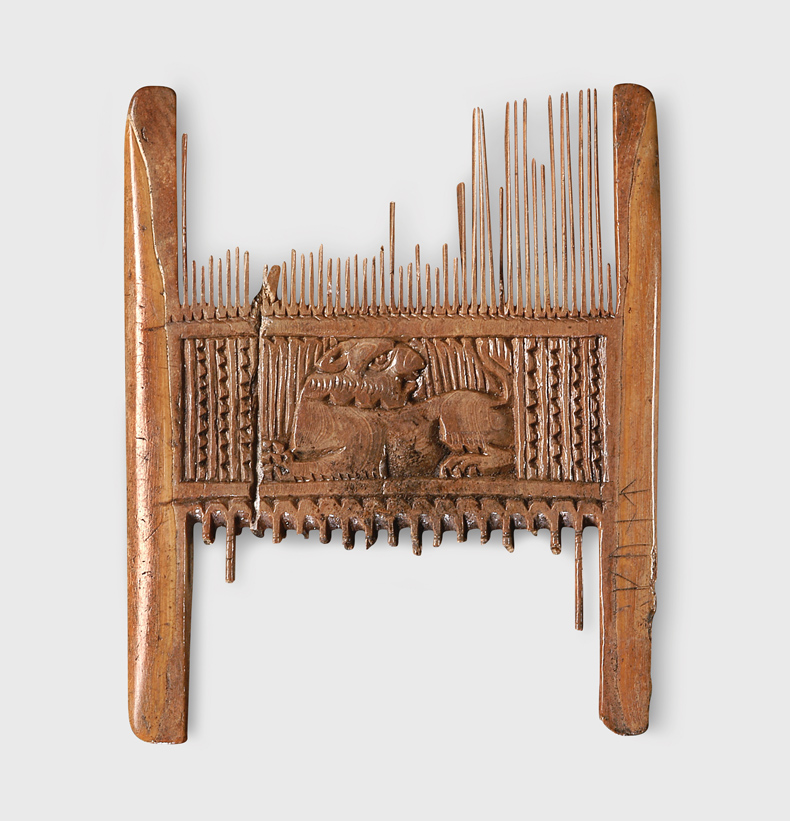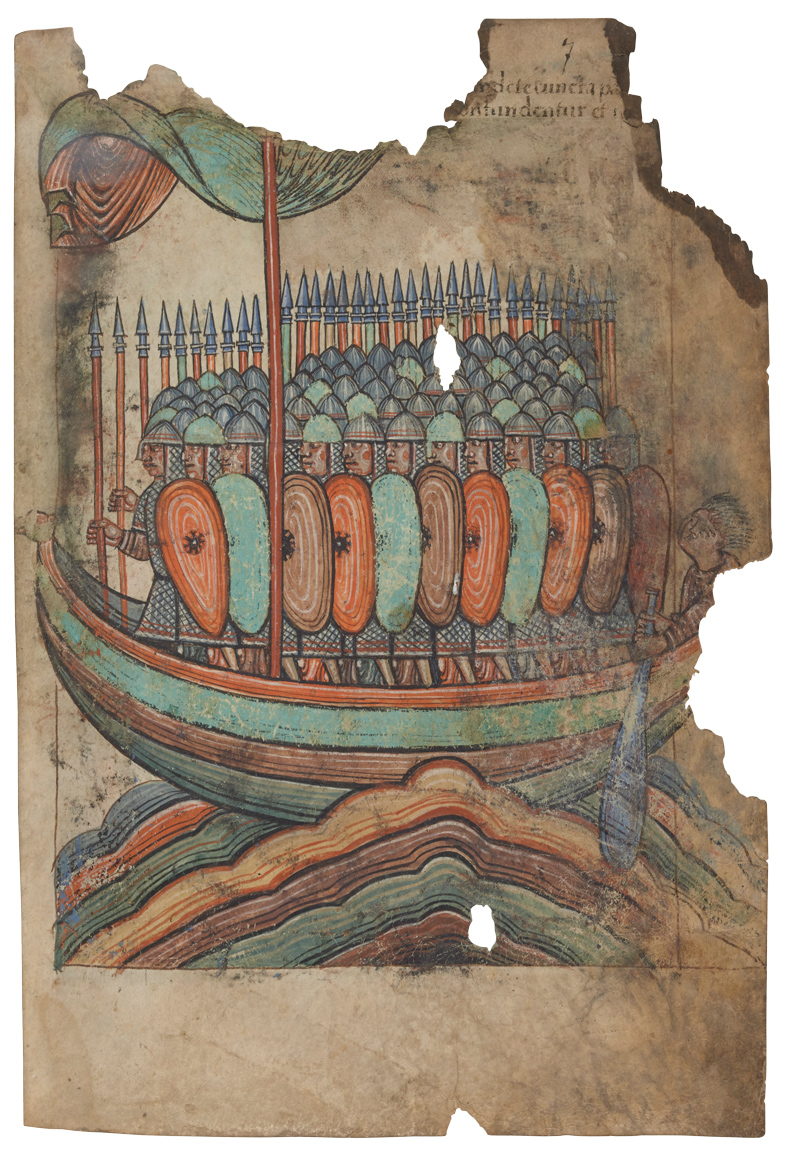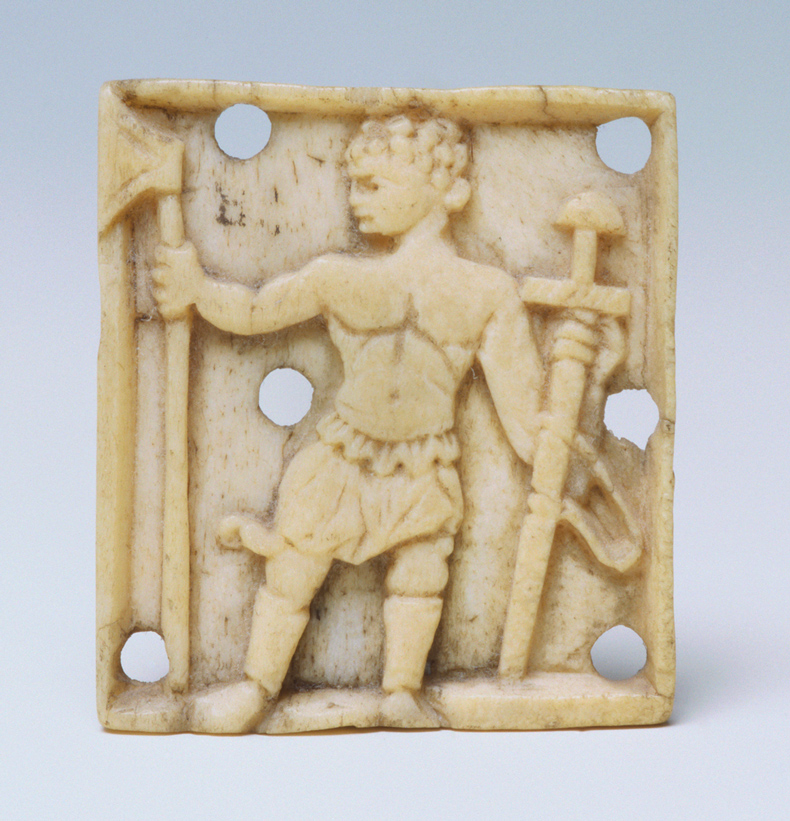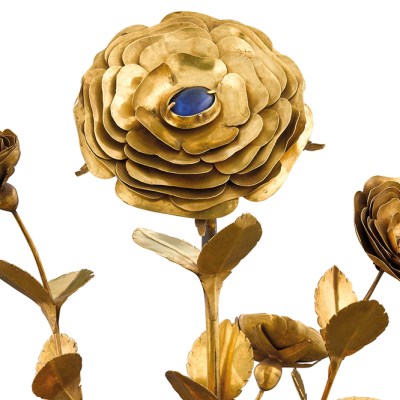From the September 2023 issue of Apollo. Preview and subscribe here.
In 1940, a small whetstone was found near a farm in Gotland, Sweden. Made of sandstone and measuring just under nine centimetres across, this unassuming object reveals the cosmopolitanism of medieval Scandinavian culture (Fig. 2). On one side, a deep groove shows where its owner sharpened needles. Touching that is a circular mould with a simple geometric design that was used to cast bronze fittings, perhaps to decorate belts. The real interest lies in the stone’s less practical side, which bears an inscription in three lines of runes. Here are two personal names: Ormika and Ulfhvatr. Then, four places: Greece, Jerusalem, Iceland and ‘Serklat’, or Serkland.
The stone may be a record of journeys taken – the 11th-century version of sharing vacation snaps on social media. It may simply be a list of places known to its maker. Either way, it offers a glimpse into a society where travel to distant places was, if not routine, also not surprising. ‘Greece’ refers to Byzantium, where medieval Scandinavians worked as merchants and mercenaries; other runic inscriptions of the time describe locals who died ‘among the Greeks’. In sagas, Serkland was a vague name for faraway lands to the south-east; it may mean ‘land of Saracens’, that is, Arabs or Muslims. The whetstone hints at Viking life far from the tired stereotypes of marauding invaders wearing horned helmets. Its owner was, it seems, a Viking who appeals to the 21st century: literate, stylish, worldly.
Whetstone with runes, called the Timans Stone, second half of the 11th century. Gotland Museum, Visby

In 2020, a conference in Mannheim presented new research on the Normans and their Viking ancestors, as part of the build-up to a large show last winter at the Reiss Engelhorn Museum. ‘Die Normannen’ is one of a cycle of exhibitions this year dealing with the tangled legacy of people who came from various areas of Scandinavia and travelled widely throughout Europe, the Middle East, North Africa and North America, some of whom developed a unified identity as ‘Normans’ along the way. In France, the Musée des Antiquités and the Musée des Beaux-Arts in Rouen are displaying a smaller part of the German exhibition, while the Musée de Normandie in Caen has a show dedicated to representations of Vikings and Normans, from the Middle Ages to the present day (until 1 October).
In Mannheim, in the case next to the whetstone was another item that points to a very different kind of medieval cultural contact: a set of leg shackles found in Wiesing, in what is now Bavaria. The Scandinavian merchants who traded with Byzantium and beyond dealt in a variety of commercial goods. Loans from the Sigtuna Museum in Sweden include dark blue beads decorated with bright silver rhombuses, a fragment of an arm band made of brown glass, also patterned with silver, a finely worked ivory comb featuring a lion and runes scratched into its side spelling KUNT (a name, or an insult), and a charming lock, made of copper alloy, in the shape of a horse. But the same merchants also sold human beings, captured in raids, in slave markets in the Khazar provinces, Volga Bulgaria and Constantinople.
Comb with depiction of a lion (c. 1075–1100), Sigtuna. Sigtuna Museum of Art

The curators in Mannheim proposed a particular view of the Normans: these were people who travelled widely, were strategic in their interactions with other cultures and, in particular, were adept at adapting to one culture after another. The German exhibition branded them as Integrationskünstler, or ‘artists of integration’, echoing the title of a book by Albert Stähli of 2015, which also referred to them as ‘Europeans from the very start’. Likewise, the catalogue for the Rouen exhibition begins by calling Normans ‘Europeans ahead of their time’. The whetstone and shackles, however, hint at just some of the difficulties posed by this undertaking.
The first issue is that the Normans, as a group, are hard to define. Raiders from Denmark, Norway and even Britain settled in north-west France in the tenth century, intermarrying with the local Frankish population and rapidly adapting to the local culture. These northmanni, or ‘north-men’ as they were known to contemporaries, came to speak French, converted to Christianity and adopted the local ways of building and showing power through patronage and monastic foundation. The
area they lived in became known as Normandy, after the northmanni who governed it. The ruling elite also commissioned histories, in which it is clear that they had a sense of themselves as descendants of northern people and maintained, as the historian Elisabeth van Houts notes, some legal practices and stories that still connected them to their Scandinavian past. Some scholarly traditions, such as the French and German, have tended to lump them together with Vikings, whereas in English writing the groups tend to be kept separate.
Mannheim began its story with Scandinavia and its Byzantine connections, then moved to the Kievan Rus, which local legend held to have been founded by a Norseman, Rurik. These disparate Scandinavian groups are only Normans by retroactive identification. Only then did the exhibition get to Normans proper and the typical medieval strategies they used to establish themselves in France: minting coins, building castles and abbeys, hiring historians to commemorate their deeds. We followed their activities into England with the Conquest and its aftermath – with a side trip into the earlier Scandinavian attacks on the country in the ninth century and the settlement of north-east England that resulted in the Danelaw. Then, it was time for the Mediterranean: Normans went to the Iberian peninsula to serve as mercenaries in the Reconquista and, finding few opportunities for growth, moved into Italy and established a kingdom in Sicily famed for its multiculturalism and tolerance. Then it was back to Byzantium and, with the Crusades, to the Holy Land. ‘Die Normannen’ ended with a short section on Norman contacts with Northern Africa and Anatolia, for which there were few objects, but an elaborate display to suggest the sights and sounds Normans might have encountered there.
Miniature depicting the attack of the Vikings (c. 1100) from The Life of Saint Aubin of Auger. Bibliothèque nationale de France, Paris

Does this sound exhausting? By the end, I felt as though I had survived a few conquests myself. After more than three hours of trying to fit it all together, I was left wondering about the logic of bundling together so many different groups of people into one story. And even then, the most astonishing case of Viking mobility – their Atlantic crossing and settlement of L’Anse aux Meadows, Newfoundland – was left out. So was their ninth-century settlement of Iceland, where they had little integrating to do, as the land was mostly uninhabited when they found it. It is of course tempting to see Scandinavians and Normans as a model for modern Europe: networked, integrated, commercially savvy. After all, their travels encompassed the continent, from Sweden to Sicily, from Kiev to York, with gracious nods all around the Mediterranean for good measure.
This, however, is where the second difficulty arises. In a German context, the word ‘integration’ immediately recalls discussions about the role of migrant communities in a country that once defined itself according to ideas of racial purity and in which the idea of a Leitkultur, or leading culture defined by Western European values, is still regularly evoked in political debates. In recent years, other German museums have also used ancient and medieval history as a counterbalance to the myth of the unchanging, eternal nation-state. In 2018, in time for the European Year of Cultural Heritage, Berlin’s Gropius Bau put on an exhibition called ‘Restless Times: Archaeology in Germany’. The show ranged from the Stone Age to the 20th century, and used archaeological finds to demonstrate the long history of movement, conflict and innovation in Europe. In the same year, the LVR-LandesMuseum in Bonn hosted ‘Europa in Bewegung’, which again focused on migrations of peoples and goods across the continent, this time in the early Middle Ages. The Rouen exhibition, titled ‘Normans: migrants, conquerors, innovators’, is even more explicit in its framing. The introduction to the catalogue notes contemporary anxieties about migration; it argues that the Normans show the extent to which modern cultures are already the result of intermixing. It also claims the Normans are an example of how immigrants, seen as ‘foreign’, can contribute to local culture and economic prosperity.
To the extent that these projects explode simplistic nationalist myths about belonging and identity, they are salutary. Take, for instance, the trilingual Harley Psalter, probably made in the court of Roger II of Sicily (r. 1130–54). In it, the psalms are rendered in Greek, Latin and Arabic in parallel columns. Each version was written by a different scribe, with its own individual style for the initials and line fillers. Marginal notes are evidence that the book was used by a Christian speaker of Arabic, but it also contains inscriptions in Italian, Greek and Latin. The psalter reflects the sophisticated culture fostered by the Norman king, whose chancery used all three languages in its documents. An illustrated volume of Muhammad al-Idrisi’s geographical work, The Pleasure Excursion of One Who Is Eager to Traverse the Regions of the World, also written under the patronage of Roger II, is another useful reminder that there have been European leaders who did not demand adherence to a single leading culture or language from their people, even as far back as the 12th century.
Illustration from The Pleasure Excursion of One Who is Eager to Traverse the Regions of the World (c. 14th–15th century, Bodleian Library, Oxford

Such exhibitions are less useful as arguments for contemporary migration, however, or as models for cultural integration. A major reason people moved around in the Middle Ages was to take land, goods and freedom from other people, often by force. The leg shackles are just one example of an object that points to a history of violence. In fact, to the extent that both Vikings and Normans were seen as coherent groups by other peoples, it was due to their warlike natures. The Anglo-Saxon Chronicle is filled with notes on the Danish, ‘heathen’ ravages of English shores. Continental sources echo it. The Benedictine monk Regino of Prüm described a crowd of peasants trying to withstand a Viking attack on his monastery: the Northmen (in Simon MacLean’s translation) ‘rushed upon them with a shout and cut them down in such a bloodbath that they seemed to be butchering dumb animals rather than men’. An 11th-century chronicle from the Abbey of Saint-Wandrille describes the arrival of the ‘barbarians’ to the Seine area, how they laid waste to cities, churches and monasteries, slaughtered both men and animals, violated maidens and took whoever was left into slavery.
In southern Europe, the Normans were more often respected for their skill as mercenaries, at various points hired to fight against Spanish Muslims, Byzantine Greeks, and, of course, neighbouring princes. A small, carved ivory tablet, probably from Constantinople, features a muscular, bare-chested man wearing shin guards and a ruffled undergarment that seems to move in the wind. The weapons he carries mark him as a member of the Varangian guard, the elite Scandinavian warriors who protected Byzantine emperors. In his left hand he holds a longsword, its point to the ground. In his right hand, he holds a Danish-style battle axe, its blade shaped like a wide skirt. (English noblemen carry the same type of axe on the Bayeux Tapestry.) This luxury item is a small reminder that the northmanni owed at least some of their cosmopolitanism to their ability to fight for money.
Ivory tablet depicting a Varangian (1000–1200), probably Constantinople. Museum Schnütgen, Cologne. Photo: © Rheinisches Bildarchiv Köln, rba_c014745

The fact that Scandinavian raiders and their warlike Norman descendants were also good at marrying local women and adapting to local ways of wielding power does not make a particularly strong argument for contemporary toleration of migrants to Europe. An English manuscript from the 12th century, containing a biography of William the Conqueror by an anonymous monk of Battle Abbey, shows how coldly mercenary the Normans could be. It contains a list of the ships William’s vassals funded for his invasion of England, probably copied from a version made shortly after the Conquest. The list names each magnate and the number of ships he contributed, usually between 40 and 60 each. In a few cases, the vassal’s later holdings in England are noted. Romo, the almoner of Fécamp, offered just one ship and 20 soldiers, but the investment paid off when he became bishop of Lincoln.
William’s wife, Matilda, also funded one ship in honour of her husband. It was named ‘Mora’, and the ship list describes its unusual figurehead, a statue of a child blowing an ivory horn and pointing towards England. The Mora appears on the Bayeux Tapestry, too, and William must have been pleased with the gift, because he sailed in it to England and granted his wife the earldom of Kent. The ship list has none of the – admittedly ambivalent – heroic propaganda of the Bayeux Tapestry. There are no smiling horses, no fresh coats of armour being carried to the boats, no eating of pre-war kebabs. It is a brisk accounting document, recording the funds and bodies the Norman nobility were willing to sacrifice in order to increase their power. Its calculated profiteering is echoed on the edges of another work depicting the Battle of Hastings: in a 13th-century miniature now at the British Library mostly taken up with a scene of war, an inset image shows men plundering the bodies lying on the battlefield.
William of Normandy stabbing Harold of England at the Battle of Hastings, (c. 1280–1300), from the Cotton MS Vitellius A. British Library London. Photo: © British Library Board. All rights reserved/Bridgeman Images

In the end, the main achievement of the recent string of exhibitions about the Normans is to show how tenuous the idea of the Normans really is, and how difficult it is to make them serve modern desires. As I walked through the show in Mannheim, I searched for some kind of cultural continuity to connect the pieces I was seeing. Finally, in the section devoted to Sicily, I found it, a showstopper: a marble relief 165cm high, featuring a man on a horse stabbing a monster from below. The warrior has a long, thick neck and short, spiky hair. His jaw is set firmly, and his eyes are eerily blank – as are those of his grinning horse. His left hand holds up a thick sword, which enters the body of the monster diagonally. Meanwhile, the monster’s feet are almost on the horse’s back, while his face and front paws twist in the other direction, unfolding like a ribbon toward the top of the marble. Its tail, teardrop-shaped, hangs over the man’s shoulder, echoing the sharp contours of his pectoral muscles.
The marble’s flat, graphic style and energetic composition looked out of place among the more classical pieces from southern Italy. Its label explained that the battle scene recalls legends of Sigurd and Beowulf. This seemed to be it, a distant memory of northern dragon-slayers in the cathedral of Aversa, something to suggest that the tolerant, multicultural Norman rule of Sicily was part of the same, larger European story as the Scandinavians who settled in Iceland and England. Then I went home and read up on the sculpture. It might be a fight between good and evil, I learned, or Saint George slaying the dragon. Or, as one scholar pointed out, it is not a dragon fight at all, because the monster has the paws, mane and tail of a lion. I looked at the image again, and saw a man fighting a lion. And the northmanni, whoever they were, once again floated out of sight.
From the September 2023 issue of Apollo. Preview and subscribe here.


